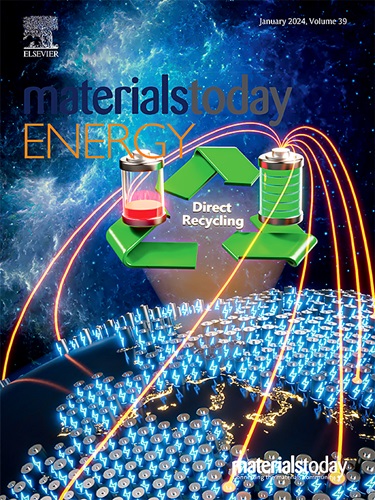Visible light-driven photoreforming of polystyrene segmented glycopolymer architectures for enhanced hydrogen generation
IF 8.6
2区 材料科学
Q1 CHEMISTRY, PHYSICAL
引用次数: 0
Abstract
In this report, a series of polystyrene segmented new glycopolymer architectures are synthesized, which are utilized in the photoreforming process to achieve a remarkable rate of hydrogen production. The primary building blocks of mono-, bi-, and tetra-functional photo-iniferter were employed in the RAFT polymerization process to design a series of block copolymer architectures using styrene and acetylated glucose methacrylate monomers. Acetylated polymer architectures exhibited higher thermal stability compared to deacetylated polymers. Deacetylated polymers showed lower T values than the acetylated polymers. In addition, a wide range of T values (55–96 °C) and variations in the T values of the acetylated polymers indicate the dependence on the nature of the pendant unit and macromolecular architecture. The deacetylated macromolecule, 1A-PS--PGM diblock copolymer exhibits a hydrogen generation rate of ∼753 μmol/g/h with an AQY of ∼1.84% compared to that of the polystyrene segment alone (53 μmol/g/h, AQY of ∼0.02%). Within the range of possible synthesized glycopolymer architectures, linear and glucose-based triblock glycopolymers show promising activity. The kinetics of the water-splitting reaction are influenced by adjustments to both the solution's pH and the hydrophilicity of the glycomacromolecular chains.可见光驱动聚苯乙烯分段糖聚合物结构的光再形成,以提高制氢能力
本报告合成了一系列聚苯乙烯分段的新型糖聚合物结构,并将其用于光转化过程,以实现显著的制氢率。在 RAFT 聚合过程中,采用苯乙烯和乙酰化甲基丙烯酸葡萄糖单体,以单功能、双功能和四功能光增感剂为主要构件,设计出一系列嵌段共聚物结构。与去乙酰化聚合物相比,乙酰化聚合物结构具有更高的热稳定性。脱乙酰化聚合物的 T 值低于乙酰化聚合物。此外,乙酰化聚合物的 T 值范围很宽(55-96 °C),而且 T 值也各不相同,这表明其取决于悬垂单元和大分子结构的性质。与单独的聚苯乙烯段(53 μmol/g/h,AQY ∼0.02%)相比,去乙酰化大分子 1A-PS-PGM 二嵌段共聚物的氢气生成率为 ∼753 μmol/g/h,AQY ∼1.84%。在可能合成的聚糖结构范围内,线性聚糖和基于葡萄糖的三嵌段聚糖显示出良好的活性。调节溶液的 pH 值和糖分子链的亲水性都会影响分水反应的动力学。
本文章由计算机程序翻译,如有差异,请以英文原文为准。
求助全文
约1分钟内获得全文
求助全文
来源期刊

Materials Today Energy
Materials Science-Materials Science (miscellaneous)
CiteScore
15.10
自引率
7.50%
发文量
291
审稿时长
15 days
期刊介绍:
Materials Today Energy is a multi-disciplinary, rapid-publication journal focused on all aspects of materials for energy.
Materials Today Energy provides a forum for the discussion of high quality research that is helping define the inclusive, growing field of energy materials.
Part of the Materials Today family, Materials Today Energy offers authors rigorous peer review, rapid decisions, and high visibility. The editors welcome comprehensive articles, short communications and reviews on both theoretical and experimental work in relation to energy harvesting, conversion, storage and distribution, on topics including but not limited to:
-Solar energy conversion
-Hydrogen generation
-Photocatalysis
-Thermoelectric materials and devices
-Materials for nuclear energy applications
-Materials for Energy Storage
-Environment protection
-Sustainable and green materials
 求助内容:
求助内容: 应助结果提醒方式:
应助结果提醒方式:


